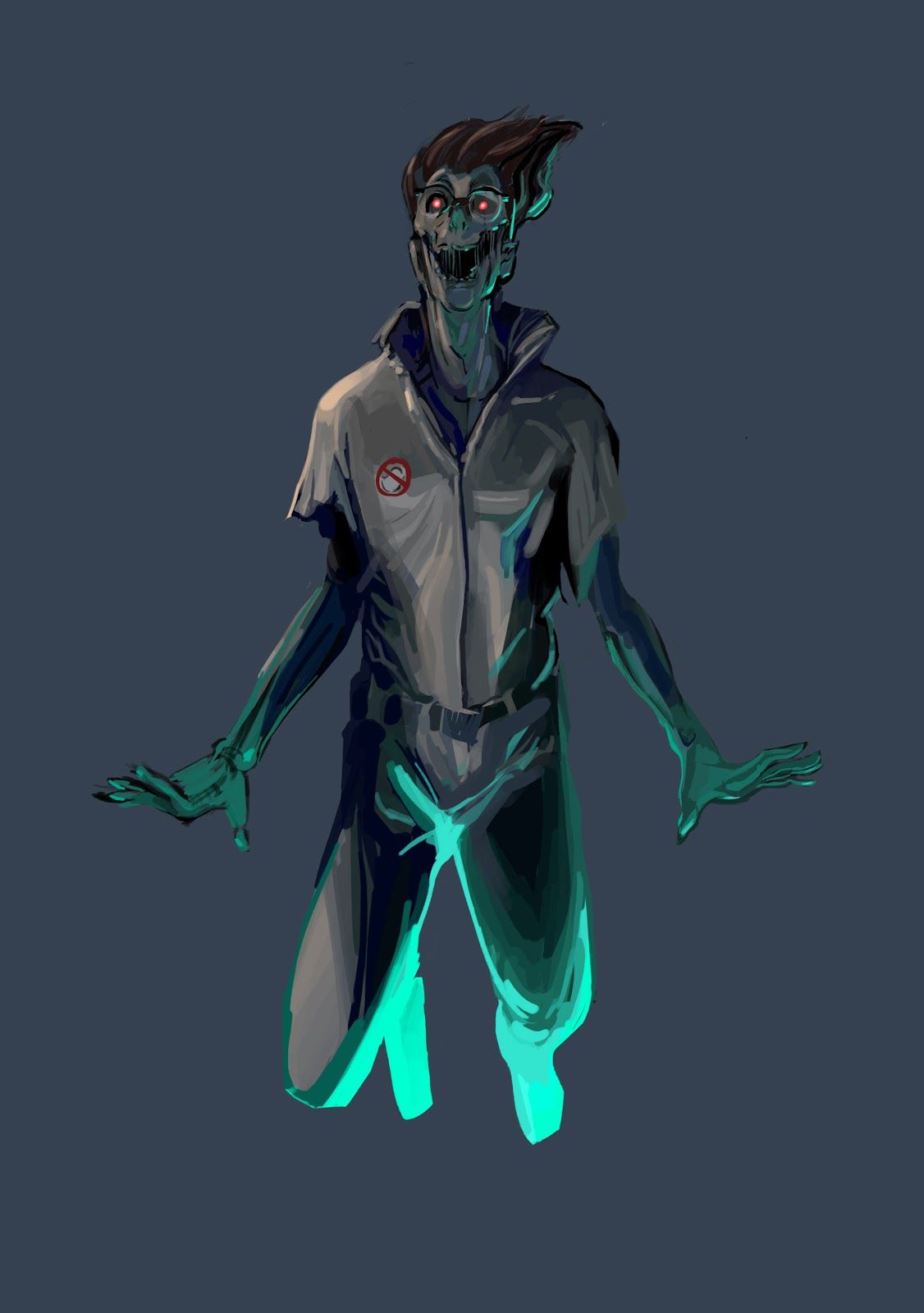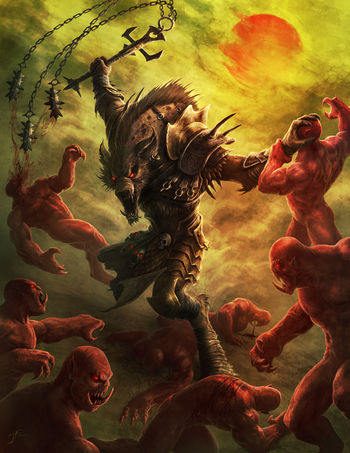The Abyss in Abholos 4
Possession
Sometimes a fiend with at least a Charisma score of at least 13 has the supernatural ability to shuck its physical form and take on an incorporeal one that enables it to possess other creatures or even objects. Its incorporeal form has the immunities normal to that creature subtype. When such a fiend possesses a creature or object, even force effects no longer affect it. Only certain spells and abilities can affect a possessing fiend (see Exorcism, for details). Any other sort of attack—magical or otherwise—directed against the fiend affects the possessed creature or object instead. While a fiend is in incorporeal form, its corporeal body (assuming it has one) lies senseless, as if in a state of suspended animation. The body does not require food or air, but direct damage or exposure to an extreme environment can kill it. A fiend can roam incorporeally as long as it desires, but it dies if its body is destroyed. If a fiend’s body is attacked or moved while it is in this state, the fiend becomes immediately aware of the tampering and can return to its body as a free action. Furthermore, successfully casting dispel magic (or a similar effect) on its body forces it to return instantly to that vessel. The caster level for a fiend’s possession ability is equal to its Hit Dice. A fiend with this ability has a Challenge Rating 2 higher than standard fiends of its kind. For example, a succubus with the possession ability is CR 7 rather than CR 5. A fiend can only move about in its incorporeal state on the plane where its body lies in stasis and the Ethereal Plane. Thus, a demon using this ability while its body is on a layer of the Abyss cannot possess a creature on the Material Plane. A fiend in this incorporeal form that moves around on its body’s plane has no access to its normal suite of abilities. It has its normal hit points and saving throw bonuses, but it lacks its extraordinary, supernatural, and spell-like abilities. It does retain its normal suite of melee attacks, but they are made as melee touch attacks, and it does not add its normal Strength bonus on damage rolls (since it has no Strength score while incorporeal).
While incorporeal on the Ethereal Plane, it has its full range of special attacks and special qualities, attacks normally, and deals full normal damage. If a fiend’s incorporeal form is destroyed, the creature’s physical form remains in its comalike state for one week while its incorporeal essence reforms. After that time, it either awakens and can resume a normal physical existence, or it can launch its incorporeal form back onto the Ethereal Plane to seek out yet another host body. A fiend with the possession ability can move between its body’s
plane and the Ethereal Plane as often as it likes as a free action. Once a fiend is on the Ethereal Plane, it floats through the world insubstantially, seeking a target to possess. If it moves to a plane other than the Ethereal Plane in this form, it is visible, but appears as a ghostly duplicate of its normal physical form. Making a possession attempt is a supernatural ability that the fi end can use at will as a standard action. If a victim successfully resists a possession attempt, it is aware that some outside entity forcibly attempted to gain control of its body, but not the source of the attack.
To use its possession ability, a fiend must be adjacent to its desired target and in incorporeal form. A protection from good or evil spell (or similar
effect) makes any creature immune to possession attempts. An unprotected target must succeed on a Wisdom saving throw (DC 10 + 1/2 fi end’s CR
+ fiend’s Cha modifier) to avoid possession. An evil target takes a –2 circumstance penalty on this saving throw, and a target that is actually committing an evil act at the time of the attempt takes a –4 circumstance penalty. The DM can roll the saving throw secretly to prevent a player from knowing whether or not his character has become possessed. Once a creature makes a successful save against possession, that fiend can not attempt to possess that creature again for 24 hours. On a failed save, the victim is possessed. A fiend in possession of a body becomes part of the victim. It is aware of what is going on around the creature whose body it possesses and can see and hear as well as its victim can. A possessing fiend can, at any time, speak mentally to the creature it possesses in a language that creature can understand, although if the victim isn’t very intelligent, its comprehension might be limited. A creature possessed by a fiend doesn’t always know that it is possessed. Furthermore, a fiend can attempt to hide its presence within the possessed creature, so that it can pass through a magic circle against evil, enter a forbiddance-warded temple, or escape detection by a detect spell or effect. To hide its presence, the fiend must succeed on a special “mental” stealth check using its Intelligence modifier rather than its Dexterity modifier. The DC for this check is 10 + level of the spell from which it wishes to hide + spellcaster’s relevant ability modifier (just like the saving throw DC of a spell). The fiend gains a +4 circumstance bonus on its Stealth check if it is not currently controlling the victim. A possessing fiend has immediate access to all of its victim’s current thoughts, as though using the detect An ill-fated victim of possession thoughts spell, except that it automatically reads surface thoughts. If desired, a possessing fiend can probe the possessed creature’s memories as well, but the victim is allowed a Wisdom save (DC 10 + 1/2 fi end’s HD + fiend’s Cha modifier) against this effect. If the save is successful, the victim keeps the fiend out of their thoughts for 24 hours.
Whether the save succeeds or fails, probing memories automatically reveals the fiend’s presence to the victim. Physical harm to the possessed creature does not harm the fiend. Killing the possessed victim forces the fiend’s incorporeal form back onto the Ethereal Plane, but it is unharmed and can attempt a new possession whenever it desires. Not even other incorporeal creatures can harm a possessing fiend.
A fiend possessing a creature can take any one of six roles with respect to its victim: ally, controller, enemy, mutterer, rider, or transformer. The fiend can switch from one role to another as a free action.
Ally: If the victim is aware of the possessing fiend and willing to serve as its host, the fi end can grant a +4 bonus to any one of the possessed creature’s ability scores. This bonus is granted at the conclusion of a bargaining period between the fiend and the possessed creature (they can communicate telepathically with each other). The fiend is in control of this bonus and can take it away as a free action if the possessed creature fails to act in a desired manner. If the possessed creature continues to disobey the fiend’s instructions, the fiend can go from ally to controller or from ally to enemy as a free action.
Controller: In the most feared form of possession, a fiend can take a standard action to attempt direct control over its victim’s actions. The victim must succeed on a Wsdoml saving throw every round (DC 10 + 1/2 fiend’s CR + fiend’s Cha modifier + 1 for each previous failed save against control that day) to avoid losing control of its own body. A successful save indicates that the victim has resisted the fi end, but the fiend can make another control attempt in the next round. A creature struggling against control is staggered and can take only a single action in a round (either a move action or standard action). If the possessed creature makes three consecutive successful saving throws, the possessing fi end can make no further attempts to control it for 24 hours. However, the fi end still possesses the creature, regardless of the success or failure of any saving throws against control. If the possessed creature fails the Will save against
control, the fi end has access to all the creature’s senses, abilities, skills, feats, and spell knowledge. The fiend now acts as though it is the possessed creature in all respects until control is relinquished or lost. During this time, the possessed creature can still communicate men-
tally with the fi end and receives all sensory input normally, unless the possessor takes a standard action each round to block the possessed creature’s access to its senses. If the fiend wishes, it can cause the victim to lose consciousness as a standard action (no save).
This condition persists as long as the fi end remains in control or until it chooses to return the victim to consciousness (a standard action). While in control, the fiend uses its own Intelligence, Wisdom, and Charisma scores, but it adopts all the possessed creature’s physical ability scores. If a fiend with at least 9 Hit Dice and an Intelligence score of 15 or higher can maintain control for at least 10 rounds per day for seven consecutive days, it can also draw upon the possessed creature’s spell-like abilities and use them at the same caster level as the possessed creature did. The fiend retains the victim’s type and is affected by spells and effects as if it actually were the possessed creature. Thus, a demon-possessed wolf is subject to spells that affect animals, even though it is more intelligent than a normal wolf. The possessing fi end automatically maintains control of its victim for a number of rounds equal to 1/2 fiend’s HD + fiend’s Cha modifier + 1 for each time the fi end has controlled this specific creature before. When the fi end’s control lapses, it can attempt to reassert control if it chooses. Fiends often choose weak-willed creatures, such as golems and other constructs, for their possession attempts. A construct can make a Will save just like any other creature to avoid possession, but it is likely that a possessing fi end can take and retain control because most constructs have poor Wisdom save modifiers. A fiend possessing a construct can aid it as described in the ally entry (see above) but must relinquish direct control to do so, allowing the construct to revert to its prior programming.
Enemy: The opposite of an ally, this sort of possessor is a serious hindrance to its victim. The possessing fiend usually takes this role after failing to control its victim, or when the victim has made it angry by failing to follow its directives while it was acting as an ally. The possessing fi end can impose a –4 penalty to any one of the victim’s ability scores. The fiend is in control of this bonus and can take it away as a free action. Typically, it removes the penalty after working out an agreement with the possessed creature through telepathic negotiations, and it might thereafter revert to an ally (a free action).
Mutterer: A mutterer enjoys planting barely perceived whispers in its victim’s mind in an attempt to influence her actions and, with luck, drive her insane. A mutterer has the same characteristics as a rider (see below), except that every so often, the mutterer cajoles, criticizes, warns, or otherwise influences its host. These “mutterings” don’t always come in the form of words. Sometimes the demon passes on whatever strong, negative emotion it is experiencing to the victim, causing its host to feel frightened, anxious, angry, or sad without knowing why. Whenever a character possessed by a mutterer is alone or under extreme stress, the demon might strike (DM’s option). The character receives emotions, advice, or other “mutterings” and might feel the desire to act on them or try to “get them out of his head.” A character plagued by a mutterer must succeed on a Will saving throw (DC 10 + 1/2 fi end’s CR + fiend’s Cha modifier). Failure means the victim must either perform a specific action in response to the demon’s mutterings (DM’s option) or spend a round befuddled, as if under the effect of a confusion spell. A successful save leaves the victim in control of its mind and actions but does not automatically tip the demon’s hand—the host might still have no idea that it is possessed. Mutterers often drive their hosts insane, or at least give them the appearance of insanity because they have a difficult time not talking back to the voices in their heads. Creatures
playing host to mutterers often appear agitated or exhausted (since some mutterers deprive their hosts of sleep), and many actually develop physical tics.
Rider: Much of the time, a possessing fiend simply rides along with its victim, giving no clue as to its presence. The fiend might combine riding with hiding to get into an area protected by forbiddance or slip past a magic circle against evil near a target it could not otherwise approach. A fiend in the role of rider might eventually decide to take on the role of ally or controller instead. Doing so makes its presence known to the victim, although a victim with a low Intelligence score might not understand what is happening to it.
Transformer: This demon wants to use its host to gain a foothold on the Material Plane. To that end, it utilizes its considerable power to transform all or part of any creature it possesses into its own demonic shape. This process usually takes considerable time and effort on the part of the demon, but the overall effect is devastating. A transformer demon can attempt only one change per day, and that change can never encompass more than one-quarter of the host’s body. Whenever it makes such an attempt, the host must succeed on a Constitution saving throw (DC 10 + 1/2 fiend’s CR + fiend’s Con modifier) to resist the change. Failure indicates that some part of the host’s body transforms, either becoming identical to the corresponding portion of the possessing demon’s normal form or gaining some sort of fiendish physical characteristic (see the Fiendish Characteristics sidebar). Whether the initial save succeeds or fails, the host must immediately attempt a Will saving throw (DC 10 + 1/2 fiend’s CR + fiend’s Cha modifier). Success means that she can communicate this transformation (or attempted transformation) to others, and the demon cannot stop her from doing so in any way. Failure means the host attempts to conceal the transformation for as long as possible.
Complete transformation takes at least four days (one for each quarter of the host’s body). Once a victim has been completely transformed, the demon has essentially taken the host’s place. At that point, the demon has access to all the powers and abilities it normally possesses. The victim is trapped within the demon—effectively functioning as a “rider” in the demon’s body—and can neither communicate nor exercise any power. Transformer demons seldom, if ever, leave their host bodies willingly. Killing a transformer demon slays the host but frees its soul for the purpose of a resurrection or raise dead spell. A transformer demon cannot be banished once it has fully changed its host, but it can still be exorcised. If the fiend is forced out of the host’s body by any means, the victim must attempt a Constitution saving throw (DC 10 + 1/2 fiend’s CR + fiend’s Cha modifier). Success frees the character of the demon and returns her body to normal; failure means the victim dies of shock but can be raised normally. Some demon cults consider voluntary transformation a religious rite. In such cases, cultists possessed by transformer demons willingly fail saving throws to resist transformation. As is their nature, however, transformer demons often use full transformation as a “reward” for the cultists offering themselves for sacrifice.







Comments